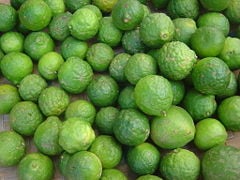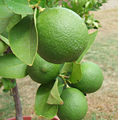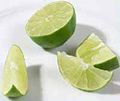Difference between revisions of "Lime (fruit)" - New World Encyclopedia
Rick Swarts (talk | contribs) |
Rick Swarts (talk | contribs) |
||
| Line 17: | Line 17: | ||
{{nutritionalvalue | name=Lime, raw (edible parts) | water=88 g | kJ=126 | protein=0.7 g | fat=0.2 g | carbs=11 g | fiber=3 g | sugars=1.7 g | vitC_mg=29 | source_usda=1 | right=1 }} | {{nutritionalvalue | name=Lime, raw (edible parts) | water=88 g | kJ=126 | protein=0.7 g | fat=0.2 g | carbs=11 g | fiber=3 g | sugars=1.7 g | vitC_mg=29 | source_usda=1 | right=1 }} | ||
'''Lime''' is a term referring to a number of different fruits (generally [[citrus|citruses]]), both [[species]] and [[hybrid]]s, which are typically round, green to yellow in color, 3-6 cm in [[diameter]], generally containing sour [[pulp]], and frequently associated with the [[lemon]]. | '''Lime''' is a term referring to a number of different fruits (generally [[citrus|citruses]]), both [[species]] and [[hybrid]]s, which are typically round, green to yellow in color, 3-6 cm in [[diameter]], generally containing sour [[pulp]], and frequently associated with the [[lemon]]. | ||
| + | |||
| + | Citrus aurantifolia - Key lime | ||
| + | Major hybrids | ||
| + | Citrus ×limonia - Rangpur lime | ||
| + | Citrus ×latifolia - Persian lime | ||
Revision as of 20:04, 20 May 2007
| Lime | ||||||||||||||
|---|---|---|---|---|---|---|---|---|---|---|---|---|---|---|
 Kaffir Lime fruit
| ||||||||||||||
| Scientific classification | ||||||||||||||
|
| Lime, raw (edible parts) Nutritional value per 100 g | ||||||||||||
|---|---|---|---|---|---|---|---|---|---|---|---|---|
| Energy 30 kcal 130 kJ | ||||||||||||
| ||||||||||||
| Percentages are relative to US recommendations for adults. Source: USDA Nutrient database | ||||||||||||
Lime is a term referring to a number of different fruits (generally citruses), both species and hybrids, which are typically round, green to yellow in color, 3-6 cm in diameter, generally containing sour pulp, and frequently associated with the lemon.
Citrus aurantifolia - Key lime Major hybrids Citrus ×limonia - Rangpur lime Citrus ×latifolia - Persian lime
notes: Lemon (Citrus × limon) is a hybrid of the plant genus Citrus, as well as the common name for the popular edible fruit of this small tree or spreading bush. The lemon plant is characterized by thorny branches and white flowers with purple edges, while the acidic, juicy fruit is oval (egg-shaped), has an aromatic rind that is typically yellow when ripe (green as immature or under certain environmental conditions), and has a prominent nipple or bulge on the blossom end.
The Citrus genus is a group of flowering plants in the family Rutaceae (orange family) that originated in tropical and subtropical southeast Asia and that have a distinctive berry with the internal parts divided into segments. Other members of the Citrus genus include oranges, limes, citrons, grapefruit, pomelos (pummelo, pommelo), and mandarins (tangerines). Most members of the Citrus genus arose as hybrids, and the hybridized types of citrus, such as lemon (Citrus limon), may or may not be recognized as species according to different taxonomies (Katz and Weaver 2003).
While the fruit of the lemon serves the plant's individual purpose of reproduction, it also serves a wider value for humans in terms of culinary and non-culinary uses. Among the culinary uses are the use of the juice in drinks, garnishes for drinks, condiments, salad dressings, and squeezed over cooked meat or vegetables. As an astringent citrus, lemons generally are not eaten on their own. Among non-culinary purposes are the use of lemon oil in perfumes, cosmetics, and furniture polish and the tree for aesthetic purposes.
For cooler winter areas, lemon and lime trees should not be grown, since they are more sensitive to winter cold than other citrus fruits. The largest producers are Italy and the United States. In the United States, lemons are commercially grown in cooler-summer/moderate-winter coastal Southern California, because sweetness is neither attained nor expected in retail lemon fruit. Other top producing nations include Spain, Greece, and Argentina.
Varieties
The color of citrus fruits only develops in climates with a (diurnal) cool winter. In tropical regions with no winter, citrus fruits remain green until maturity, hence the tropical "green orange." The lime plant, in particular, is extremely sensitive to cool conditions, thus it is usually never exposed to cool enough conditions to develop a color. If they are left in a cool place over winter, the fruits will actually change to a yellow color. Many citrus fruits are picked while still green, and ripened while in transit to supermarkets.
Katz and Weaver (2003) claim that the generally accepted view is that there were three primordial Citrus species—Citrus medica (citrons), Citrus maxima (pumelos), and Citrus reticulata (mandarins)—and that all other types of citrus rose from single or sequential hybridization events between these species or their offspring. The hybridized types of citrus may or may not be recognized as species according to different taxonomies. Thus, anywhere from 3 to 170 species are recognized, with the commonly used system of Swingle recognizing 16 species (Katz and Weaver 2003). The lemon is a cultivated hybrid deriving from wild species such as the citron and mandarin.
The limes most commonly available commercially are the smaller, yellower Key lime (Citrus aurantifolia) and the larger, greener Persian lime (Citrus × latifolia).[1] "Key lime" is an American retronym, as the original fruit known in English as a "lime" was Citrus aurantifolia, derived from the Persian name لیمو, limu (the fruit was introduced to Europe during the Crusades). Other limes include the Mandarin lime (Citrus limonia), Kaffir lime (Citrus hystrix), the various Australian limes, Spanish lime (Melicoccus bijugatus), wild lime (Adelia ricinella), sweet lime (Citrus limetta), Palestine sweet lime (Citrus limettioides), and musk lime (X Citrofortunella mitis).[2] The limequat is a lime-kumquat hybrid.
Uses
Astringent citrus, such as lemons and limes, are generally not eaten on their own. Both lemons and limes are regularly served as lemonade or limeade by diluting the juices of these fruits and adding sugar. Lemons and limes are also used as garnishes for drinks such as iced tea or a soft drink, with a slice either inside or on the rim of the glass. Only lemons, however, are used in the Italian liqueur Limoncello. A wedge of lemon is also often used to add flavor to water. Marmalade, a condiment derived from cooked orange and lemon, can be especially bitter.
Lemons and limes are used as an ingredient in a variety of dishes and their juice can commonly be found in salad dressings and squeezed over cooked meat or vegetables. Lemon juice is typically squeezed onto fish dishes; the acidic juice neutralizes the taste of amines in fish by converting them to nonvolatile ammonium salts. In addition, lemon juice is widely used, along with other ingredients, when marinating meat before cooking: the acid provided by the juice partially hydrolyzes the tough collagen fibers in the meat (tenderizing the meat).
Limes in drinks
Lime fruit, and particularly their juice, are used in beverages, such as limeade (akin to lemonade). Alcoholic beverages prepared with limes include cocktails such as gin and tonic, margarita, mojito, and Cuba libre, as well as many drinks that may be garnished with a thin slice of the fruit or corkscrew strip of the peel (twist). One customary consumption of tequila is in shots accompanied by lime wedges and salt. Beer is often served with limes in Mexico, as well as some other countries. Lime juice is also used in commercial soft drinks.
Limes in cooking
In cooking, lime is valued both for the acidity of its juice and the floral aroma of its zest. It is used in tacos, Key lime pie, a traditional Florida dessert, and is a very common ingredient in authentic Mexican and Southwestern American dishes. It is also used for its pickling properties in ceviche. Additionally, the leaves of the Kaffir lime are used in southeast Asian cuisine. The use of dried limes as a flavoring is typical of Persian cuisine and Sprite.
Other uses
In order to prevent scurvy during the 19th century, British sailors were issued a daily allowance of citrus such as lime (presumably Citrus aurantifolia), which led in time to the nickname "limey" for all Britons. It was later discovered that this beneficial effect derived from the quantities of Vitamin C the fruit contains.
Lime extracts and essential oils are frequently used in perfumes, cleaning products, and aromatherapy.
Lime Associations & Organizations
AFABLE (Association For A Better Lime Experience) was founded in 2002. This organization seeks to promote the use of lime in everyday cooking, and believes that lime needs better culinary representation. AFABLE members believe that lime is the most flavorful, delicious citrus.
Production trends

According to FAO, Mexico produced almost 12% of the global output of lemons and limes in 2005 followed by India, Argentina, Iran and Brazil.
Fruits known as "lime"
- Australian limes
- Australian desert lime (Citrus glauca)
- Australian finger lime (Citrus australasica)
- Australian round lime (Citrus australis)
- Blood lime
- Kaffir lime (Citrus hystrix) (a.k.a. kieffer lime; makrut, or magrood)
- Key lime (Citrus aurantifolia) (a.k.a. Mexican, West Indian, or Bartender's lime)
- Mandarin lime (Citrus limonia)
- Musk lime (X Citrofortunella mitis)
- Palestine sweet lime (Citrus limettioides)
- Persian lime (Citrus x latifolia) (a.k.a. Tahiti or Bearss lime)
- Spanish lime (Melicoccus bijugatus) (a.k.a. mamoncillo, mamón, ginep, quenepa, or limoncillo) (not a citrus)
- Sweet lime (Citrus limetta) (a.k.a. sweet limetta, Mediterranean sweet lemon)
- Wild lime (Adelia ricinella)
- Limequat (lime × kumquat)
See also
- Lime tree (Tilia sp.)
Gallery
ReferencesISBN links support NWE through referral fees
- Herbst, S. T. 2001. The New Food Lover's Companion: Comprehensive Definitions of Nearly 6,000 Food, Drink, and Culinary Terms. Barron's cooking guide. Hauppauge, NY: Barron's Educational Series. ISBN 0764112589.
- Katz, S. H., and W. W. Weaver. 2003. Encyclopedia of Food and Culture. New York: Schribner. ISBN 0684805685.
- Citrus aurantifolia Swingle
- Tahiti Lime
- Citrus (Orange, Lemon, Lime, Grapefruit, Naartjie genus)
- Hort 403 - Lecture32
- Key Limes (Citrus aurantifolia)
External links
Credits
New World Encyclopedia writers and editors rewrote and completed the Wikipedia article in accordance with New World Encyclopedia standards. This article abides by terms of the Creative Commons CC-by-sa 3.0 License (CC-by-sa), which may be used and disseminated with proper attribution. Credit is due under the terms of this license that can reference both the New World Encyclopedia contributors and the selfless volunteer contributors of the Wikimedia Foundation. To cite this article click here for a list of acceptable citing formats.The history of earlier contributions by wikipedians is accessible to researchers here:
The history of this article since it was imported to New World Encyclopedia:
Note: Some restrictions may apply to use of individual images which are separately licensed.



